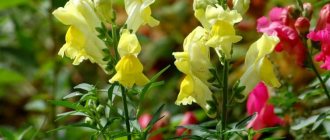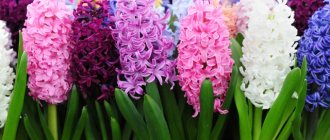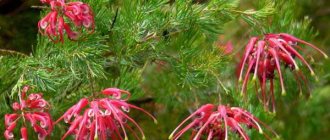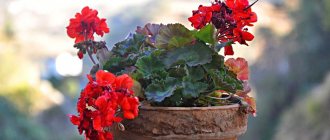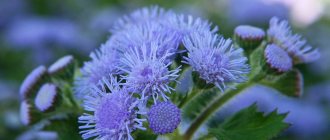Low herbaceous plants with lush greenery and bright flowers are Torenia. The buds have an original shape, reminiscent of an Orchid or Gloxinia, but the size of the flowers is smaller. Plants decorate cottages, gardens, flower beds near houses, balconies, terraces and loggias.
Where to plant an annual? What soils does Torenia prefer? Growing and care, preparing seedlings, choosing the right variety, disease prevention, descriptions and photos, advice from experienced gardeners - interesting and useful information for fans of bright colors and green decor.
Torenia: types and varieties for open ground
General information:
- herbaceous annual;
- the plant belongs to the Norichinaceae family;
- Torenia’s homeland is the humid zones of Africa, the tropical regions of Southeast Asia;
- a low bush with a creeping stem, average size - up to 30 cm;
- medium-sized flowers are similar to gloxinia and orchid, the shade of the upper and lower “lip” is often different;
- The color of the petals is varied: white, crimson, lilac, pink, yellow, blue, purple;
- Many hybrid varieties have been bred;
- many varieties have bright spots on the lower “lip”;
- the plant is highly decorative;
- buds bloom in August;
- a herbaceous perennial with spectacular inflorescences is grown in open ground and at home.
The herbaceous annual has many traditional varieties and hybrids. In natural conditions, botanists have counted more than forty varieties of Torenia. Many species have been cultivated, many interesting hybrid flowers with a varied combination of shades of the upper and lower “lips” have been bred. Before choosing flowering decor for a garden, cottage, or balcony, it is useful to find out more information on the topic: Torenia, photos, varieties.
Kawaii
Original petal color: magenta and lemon drop. An unpretentious, drought-resistant annual. A highly ornamental plant is a spectacular decoration for any area. The Toreniya Kawai variety is often used to decorate balconies and terraces.
Yellow
A spectacular variety of herbaceous perennial. The bushes are lush, branched, the stems are 25–30 cm long. The petals are deep yellow, with a bright purple spot on the lower lip.
Kauai mix
Early flowering variety, ampelous type of torenia. Small bushes (up to 20 cm in height) have many flexible branches. The plants are compact, neat in shape, suitable for decorating balconies, loggias, and growing in flowerpots. Long flowering period, wave-like release of buds. The highly decorative variety is often combined with other hanging torenia varieties.
Fournier
A popular variety with highly branching elements. The plant is grown at home and on the site. The leaf blades are ovoid, long, the buds are on short peduncles. The shade of the petals and lips is most often a combination of purple and deep blue. Breeders have developed interesting subspecies with new colors of lips and petals.
1.Seven secrets of success:
| 1. Growing Temperature: Can be grown in a warm place with temperatures ranging from 18 to 22°C throughout the year. |
| 2. Lighting: light shading from direct rays of the sun on especially hot summer days; in the morning and evening, torenie can sunbathe for 3 - 4 hours daily. |
| 3. Watering and air humidity: water the torenia abundantly, slightly drying the top layer of soil to a depth of 2 - 3 cm between waterings. Spraying is not necessary. |
| 4. Pruning: after flowering, it is necessary to remove the flower stalks, and then the withered, brown leaves. Pinch the tips of young shoots to form side branches. |
| 5. Soil: excellent drained, nutritious substrate with a loose structure and a wide pH range. |
| 6. Feeding: mineral fertilizers for flowering plants every 2 weeks in spring and summer. In the winter months, the frequency of fertilizing is reduced to once a month. |
| 7. Reproduction: spring sowing of seeds. |
Botanical name: Torenia.
Torenia flower - family
Origin. Tropical regions of Asia.
Description. Torenia are dense small shrubs, among which there are annual and perennial varieties. The leaves are green, simple, with pronounced veins, lanceolate, about 5 cm long, arranged oppositely, in pairs. The edges of the leaf blades are serrated. These plants are characterized by abundant and long-lasting flowering. Flower shades contain almost the entire color gamut, including varieties with two-color and three-color flowers. The diameter of the flowers is 3 - 4 cm.
Height. 20 - 30 cm, indoor torenia grows very quickly.
Growing from seeds to seedlings
The best option for growing on the site or growing torenia as a potted crop for decorating balconies, loggias and terraces. Seedlings have been started since mid-February. To increase the percentage of germination, it is useful to treat planting material with growth stimulants.
After planting, the soil is sprayed, covered with glass or polyethylene is used: it is important to maintain high humidity during the “black earth” period. Every couple of days, the mini-greenhouse is opened slightly for 15 minutes: ventilation prevents the development of mold. Condensation is also removed.
Soil and container
To germinate seeds, use peat pots, a common container or a wooden box. The nutritious, light substrate contains charcoal and sand, peat, and garden soil.
You can purchase potting soil at a flower shop. The finished substrate is calcined to kill fungal spores. Another option for disinfecting the base is to water the soil with a strong solution of potassium permanganate.
Seedling care
After the first seedlings appear, the protective layer (polyethylene or glass) is removed and fresh air is allowed in. The container with torenia sprouts should be in a room with a moderate temperature: during the germination of grains, the optimal indicators are about +20..21°C. Sprouts need a cooler environment - about +18°C, otherwise the seedlings will grow before it gets warm enough outside and frosts on the soil stop.
Seedlings are grown taking into account the recommendations:
- watering. Moisten the substrate in a timely manner and monitor the condition of the soil: waterlogging is not necessary, but the dryness of the base also interferes with the active growth of seedlings. The water is settled and must be warm. Periodically loosen the substrate with a miniature tool;
- temperature. Do not keep peat pots with seedlings in a hot room, in direct sunlight. Do not allow the seedlings to dry out in a stuffy room. With a lack of light, the sprouts stretch out strongly in search of the sun, become thinner, and weaken. The optimal temperature for growing torenia seedlings is about +18°C;
- picking. When two leaves form, it is time to transplant the grown seedlings into separate containers, if the plants were in a common container. Act carefully, after moistening the substrate. Picking is stress for plants. After transplantation, it is useful to water the soil with the immunomodulators Zircon or Fitosporin to support torenia seedlings under the influence of negative factors;
- hardening. A mandatory procedure, without which seedlings cannot be planted on the site. Preparation continues for two weeks. The first two days, the seedlings are on the balcony for a quarter of an hour, then - 30-40 minutes, after four to five days - 1-2 hours, and so on. After two weeks, the hardened seedlings should spend the night in the fresh air. It is important that there is no frost, otherwise the sprouts will freeze.
Transplanting
Torenia sprouts are transplanted to the site only after the frosts have stopped. It is important that the air temperature is at least +16..18 degrees. The seedlings are first hardened off (the rules are described above).
To plant seedlings, you need a warm day, preferably with high clouds, but no rain. Strong wind, fog, heat are negative factors that negatively affect newly transplanted sprouts of an ornamental plant.
Choice of location and lighting
Warmth and sufficient light levels are optimal conditions in regions with a temperate climate. If a low-growing ornamental species is planted in hot areas, then it is useful to choose an area with light shade so that the delicate stems, leaves and buds do not get burned from the scorching sun.
For planting, choose a site that is not drafty, without swamps, and with a nutritious and loose substrate.
It is harmful if the plant experiences sudden changes in temperature. On a note! It is important that there are no stones in the soil: the plant is demanding on the quality of the soil. Be sure to remove weeds from the site and loosen the soil: harmful grasses often “clog” low-growing annuals with thin, often creeping, stems.
Landing rules
It is important to take into account the advice of experienced flower growers:
- check the area, remove weeds with their roots, loosen the damp, slightly dry soil;
- Dig small holes for each seedling. An interval of about 20–25 cm is maintained between the pits;
- first moisten the soil moderately, add a little organic fertilizer, then dig up the substrate and carefully level the surface;
- Place the sprouts in the holes, sprinkle the roots with soil, and tamp them down a little. There is no need to deeply bury young torenia;
- after planting, add a little settled, moderately warm water under each bush, wait until the moisture is absorbed, and mulch the planting area;
- fertilizing is carried out after 10 days;
- Young plants are watered moderately, make sure that weeds do not grow more actively than the herbaceous species, and periodically feed them.
Features of the transplant
To ensure normal development of the plant, seedlings must be hardened off before transplanting. To do this, it is gradually adapted to new conditions. First, the plants should be taken outside for 2 hours. By the end of the second week, the plants should be left outdoors overnight.
Then you need to mark the flowerbed and make holes for planting the sprouts. After this, you need to make holes and put a small amount of humus and ash in them
Carefully remove the seedlings from the container and move them into the recess. In this case, the clod of earth should not be destroyed
Then you need to carefully add soil from all sides and squeeze it with your hands. This will help get rid of air cushions. Following these recommendations will help Torenia quickly settle into a new place.
Finally, the seedlings should be watered with warm water. In hot weather, mulch should be spread around the bushes. This will help minimize moisture evaporation and accelerate the growth of the young crop.
Outdoor care
A fairly unpretentious torenia plant develops well in partial shade and moderate lighting. The “transparent”, sparse crown of trees on the site does not interfere with abundant flowering and, at the same time, prevents the harmful effects of the scorching sun.
The main measures for caring for herbaceous annuals: moistening the substrate, adding organic matter and minerals, loosening, weed control, mulching. Transplantation of an annual species is not carried out unless there are serious indications, for example, infected plants have appeared on the site: a virus, fungus, dangerous bacteria.
Watering
Short periods of drought are less harmful to torenia than clayey, dense substrates and islands of water near the bushes, but it is more useful to stick to the golden mean. The soil is moistened as the top layer dries, taking into account the volume and frequency of precipitation. Water the plants quite often, but the amount of liquid is moderate.
Important details:
- During the release of buds, you need to carefully monitor the level of soil moisture: if the substrate is very dry, the flowers often wither and fall off, or the bright colors please the eye for a shorter period.
- When watering, proceed carefully: use a watering can with a long, narrow spout so that drops do not fall on the buds and leaves.
- Do not add cold liquid to the substrate.
- Infrequent loosening increases the risk of soil salinization; a dense crust is formed, which impairs soil aeration.
Disruption of the usual state of the environment negatively affects garden flowers. Fitosporin is a natural remedy that stimulates the immune defense and vitality of plants. On very hot days or when there are sharp temperature fluctuations, it is useful to water the fermentation with a working solution based on succinic acid.
Feeding and fertilizer
Mineral compounds and not very strong organic matter are added during the growing season and flowering period: natural and synthetic components alternate. Feeding is carried out every two weeks.
The soil is immediately moistened, then nutrients are added. To gain green mass, in the first period (vegetation) of threshing it should receive more nitrogen and phosphorus; during the release of buds and with the beginning of flowering, the concentration of Na is reduced and the concentration of potassium is increased.
Care during and after flowering
It is useful to water the low-growing species in time, loosen the substrate, and carry out weeding without delay so that weeds do not interfere with the growth and release of buds. All withered elements are removed in time, which activates the formation of new buds. Be sure to apply mineral fertilizers containing potassium.
On a note! If the plants are planted in an area with optimal illumination (with light shading during hot hours), then torenia will certainly please the eye and refresh the area.
Bush formation
For the first time, grown seedlings are pinched: the length of the sprouts reaches 8 cm. In young plants, after transplanting into a flowerpot or onto a plot, the upper stems are pinched: the plant bushes more actively. If necessary, remove all rotten, dry, broken, fungus-damaged elements from the tree. For varieties that resemble a ball, it is useful to maintain the optimal shape of the bush: at the beginning of summer, while the growing season is active, the stems are pinched in the right places.
Mulching, loosening
When growing torenia in flowerpots and on the plot, it is useful to periodically fluff up the soil for more active aeration. Loosening is carried out on a soft, loose substrate, which is pre-moistened. Weeds are removed as work progresses.
Peat mulch is poured in a thin layer under each bush when planting seedlings, and updated as necessary. Peat not only actively nourishes the soil during watering, but also prevents weeds from breaking through the mulch layer.
Feeding stages
Grapes are an unpretentious crop that can bear fruit even on sandy soil. Such soil protects the crop from water retention and provides oxygen access to the roots. Unfortunately, the necessary substances are quickly washed out of it. Therefore, for successful fruiting, it is recommended to feed grapes several times a season.
Properly selected fertilizer can work wonders in increasing the yield and improving the taste of the berries. There are several stages of spring and summer fertilizing of crops:
- Immediately after wintering. Pour 20 grams of superphosphate, 10 grams of ammonium nitrate and 5 grams of potassium into a ten-liter bucket of water. This amount of solution is enough for one bush. This fertilizing can be replaced with special liquid manure.
- Two weeks before flowering, the above-described composition is given again.
- Before the berries ripen, each bush is given a mixture of potassium and phosphorus.
- If the summer is cold, then the plants are fed with any fertilizers with a high potassium content.
Protection from pests and diseases
With proper care, torenia rarely gets sick. The stems may wilt and dry out if there is a lack of moisture; if there is excessive watering, fungus will develop. They fight mold on leaves, stems and soil using antimycotic agents - fungicides: Topaz, Skor, Bordeaux mixture, Hom, Fundazol, copper-containing compounds. The drugs are used according to the instructions. If the fungus is actively spreading, experienced gardeners advise disposing of the diseased bush so that mold spores do not fall on neighboring plants. Next, the area must be disinfected.
Important details:
- When harmful insects are identified, parasites are collected manually and all parts of the tree are inspected.
- When the colony size is small, folk remedies are used to treat infected plants: soap solution, garlic tincture, tobacco decoction. When pests actively multiply, insecticides are used.
- When spider mites settle in a dry environment, chemicals from a different group are used to kill pests - acaricides.
- It is important to normalize growing conditions, prevent waterlogging and drying out of the soil.
- To prevent the infestation of parasitic insects and mites, it is useful to prepare the soil according to the rules, and the purchased substrate must be disinfected.
- You should not allow dense plantings: a lack of space for growth and development makes the plants weaker, making it easier for pests to move from bush to bush.
- When using chemicals, the grower must protect the body from contact with acaricides and insecticides. You will need closed clothing, a hat, plastic glasses, thin rubber gloves, and a respirator. Neglecting simple safety measures increases the risk of vapors and droplets penetrating the skin, mucous membranes, respiratory tract and eyes.
Growing plants
Torenia seedlings develop quite quickly, overtaking all competing summer shoots; a very short period usually passes before diving. Young seedlings are protected from soil drying out and waterlogging by careful watering by spraying as the soil dries.
The lighting and temperature for the seedlings of this summer plant are left the same, but if it is possible to lower the temperature to 18 degrees, then a slightly cooler content can be provided. It is better to remove glass or film from containers as quickly as possible, as soon as the first shoots appear.
Reproduction
Torenia is bred at home and on the site only with the help of seeds. They are engaged in seedlings according to the recommendations given in the previous sections. Some gardeners sow seeds directly onto the plot, but only in warm regions do bushes and flowers have time to form.
You need to remember: buds form in August; when grown without seedlings, the flowering period occurs in autumn with unstable temperatures and less favorable conditions. Weak bushes bloom worse and get sick more often.
Caring for torenia correctly
Torenia is capricious, growing and caring for it requires knowledge of certain rules.
Rule one: although the flower loves the sun very much, at the same time it cannot stand its direct rays. Delicate velvet flowers dry out, so torenia should grow in places with diffused light.
Second: the soil in the pot should always be moist; you can use hydrogel granules for this. If the air is too dry, the plant is thoroughly sprayed.
Third: the plant does not tolerate sudden temperature changes, so indoor planting should not be located near a radiator or in a draft.
Fourth: when watering, drops of moisture should not fall on the flowers and leaves.
Fifth: home care requires careful loosening of the soil to better ventilate the roots and prevent the development of mold in the soil. Every 14 days, the torment needs to be fed with fertilizers for indoor flowers (complex liquid or solid mineral).
Sixth: to enhance flowering, faded buds and wilted flowers are removed from the bush - the plant does not know how to shed them on its own.
Torenia in landscape design
Note to amateur flower growers:
- Low, compact and ampelous varieties of highly decorative annuals look good against the backdrop of a well-groomed, green lawn.
- An interesting planting option: a combination of bright colors of decorative tobacco, torenia and petunia.
- Hanging varieties with creeping elements are a delicate, effective decor for hanging flowerpots and decorative, rather tall floor vases. Place the compositions on the loggia, balcony, terrace, and decorate the patio area.
- Torenia can be used to make a low border, but varieties with creeping stems are not planted close to the edge of paths. Low-growing, compact varieties that look like large balls are suitable for decorating this zone.
- Fresh notes are given to the garden and dacha by planting torenia, which involves several varieties with a similar bush shape, but a different shade of petals.
- You can choose two or three varieties with rich crimson, lilac, yellow, white petals and a lip on which there are rich spots of color.
- Torenia plantings are never boring, especially when using the optimal combination of tones.
Suitable companion plants:
- Marigold.
- Salvia.
- Aquilegia.
- Verbena.
- Nasturtium.
- Sulfinia.
- Petunia.
When combining with other plants, it is important to consider what type of low-growing flower the grower is growing: ampelous or groundcover.
Torenia is an interesting herbaceous species for decorating a garden, balcony, or patio area. Unusual flowers combine the characteristics of orchid and lobelia; rich green shades complement the bright colors of the buds. Growing torenia from seedlings is quite simple; seed germination is sufficient. In general, the plant is unpretentious, and every year it gains recognition from an increasing number of amateur gardeners.
Want to know more useful information about growing Torenia? Watch the video below:
Application
Torenia is very popular in the UK, its profuse summer flowering makes it an ideal annual for decorating areas in partial shade, as ground cover in beds and embankments, in borders, rock gardens or simply in pots.
Torenia can be grown in boxes, hanging baskets, and flowerpots. When planting in large flower pots, you can place them under a canopy of shrubs with decorative leaves, which will provide the necessary shade at certain times. For example, you can place pots under ferns, hostas, coleus or taller plants that place the flowers high enough so as not to compete with torenia, such as Abyssinian gladioli. Ampelous green plants can be planted on the periphery of the containers.
Torenia can also be planted in the garden, taking care of constant watering. It looks beautiful on borders. Also a good choice for planting along northern walls or under trees and shrubs.
This bright and cheerful flower will look great in the garden and on the balcony. Torenia is a valuable addition to a shady garden, terrace or loggia, which it will decorate for several months.
